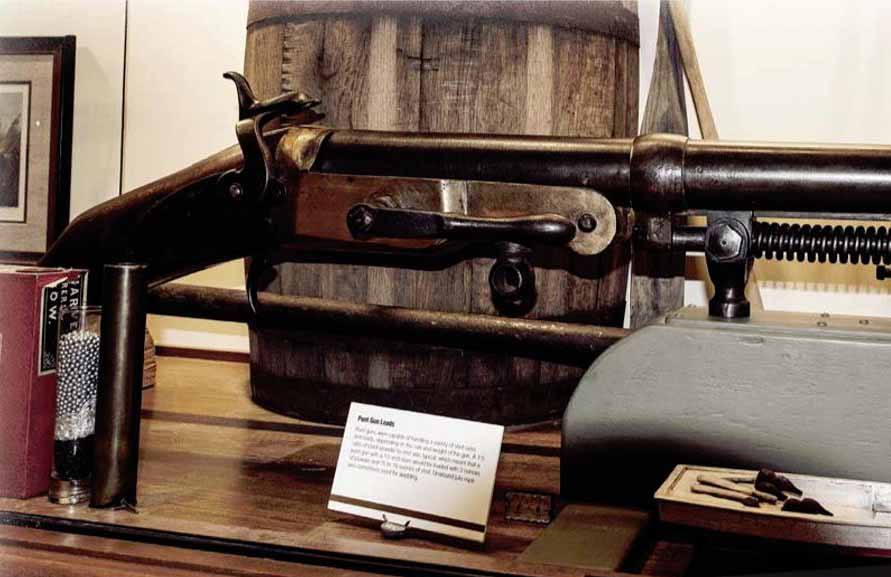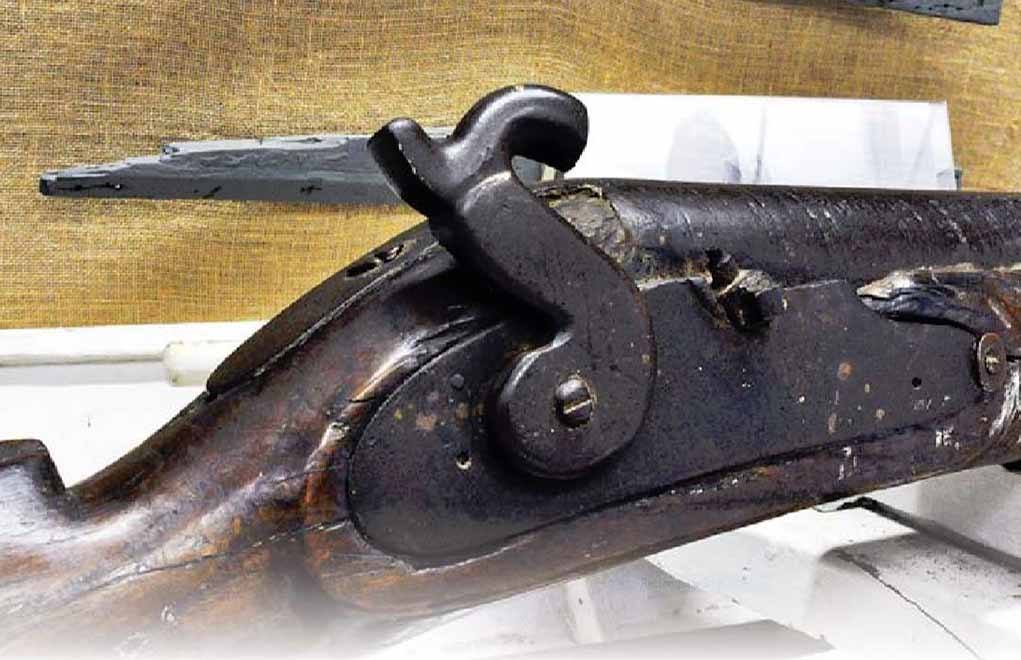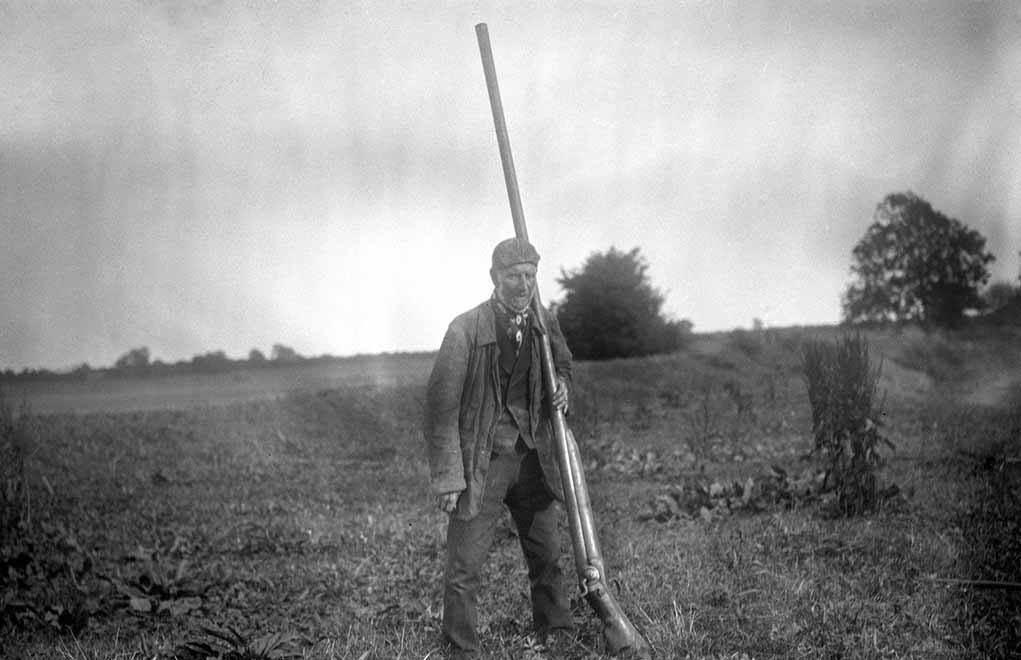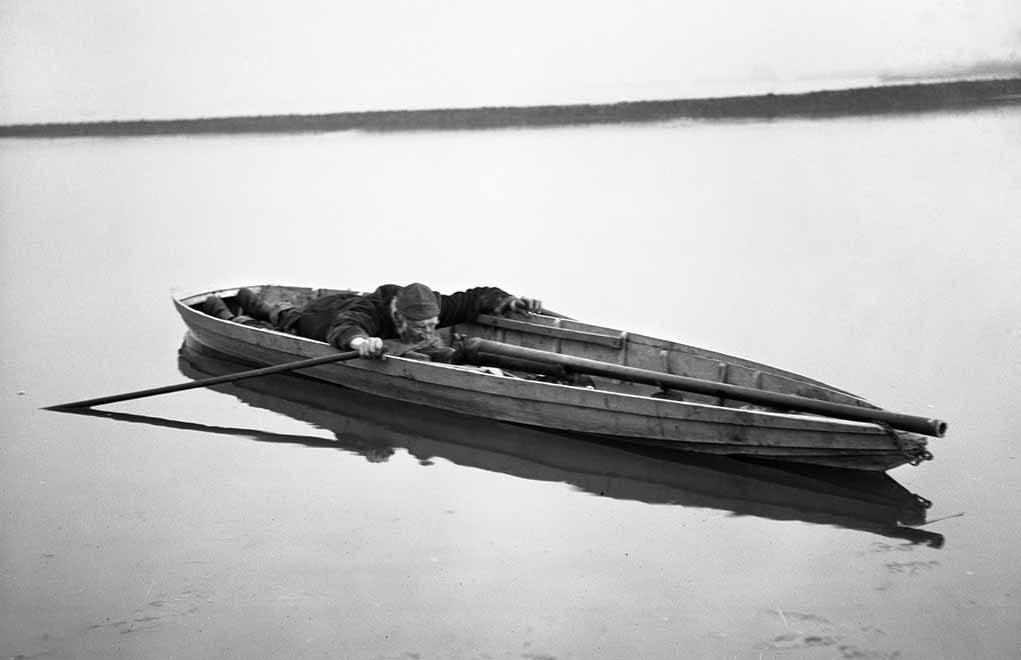

If utilizing a punt gun sounds like a dangerous proposition—firing an oversized shotgun from a fragile craft in frigid conditions at night—it was.
What Exactly Is A Punt Gun:
- Generally, an oversized blackpower shotgun with a bore from 1½ to 2 inches.
- Most specimens weight 100-plus pounds and could measure up to 12 feet in length.
- Typically used in conjunction with a small skiff (or punt) for waterfowling.
- Used around the heyday of the market-hunting era around the turn of the 20th Century.
Punt guns were oversized black-powder shotguns used by market hunters in the late 1800s and early 1900s. They were capable of downing scores of ducks with a single shot. However, to impugn them is to misunderstand the purpose, economic demands of the time and the world in which market hunters lived.
These were specialty guns, relatively rare, singular and deadly effective in purpose in the hands of skilled hunters plying their trade in a time of flocks of ducks so thick they darkened the sky.
A 1914 listing of “owners of big guns in the vicinity of Susquehanna Flats, Maryland,” listed 16 owners, three of them with two big guns each, for a total of 19 guns.
A description of the guns stated, “These guns are all about the same weight—100 to 125 pounds; length, 12 feet; diameter of bore from 1½ to 2 ins [inches].”

Burskey Bouchelle, Upper Bay Museum)
These guns of awesome dimensions are often associated with Chesapeake Bay and the Atlantic seaboard, where many were employed in feeding the seemingly insatiable demand for wildfowl in the finest restaurants in the East.
The listing of big-gun owners is published in one of two definitive works on marketing hunting. The Outlaw Gunner by Harry M. Walsh (1971; Tidewater Publishers) focuses on the Chesapeake Bay area, home of the market-hunting heyday. The second book, Texas Market Hunting: Stories of Waterfowl, Game Laws and Outlaws by R.K. Sawyer (2013; Texas A&M University Press), covers the rise and fall of market hunting along the Texas coast.
Although the punt gun was more common with hunters on the Atlantic seaboard, some Texas market hunters, quick to pick up on successful tactics of the Chesapeake Bay watermen (shooting from sink boxes was another), manhandled cumbersome punt guns. As Sawyer states, the punt gun “was the most infamous, considered ‘the deadliest weapon known to waterfowl bagging.’”
Walsh said that even in the heyday, around the turn of the century, there were probably fewer than 100 guns in operation around Chesapeake Bay— more than on the list because, undoubtedly, many went unreported.
Market Hunting Heyday
The culinary demand, along with the market hunting trade, picked up after the Civil War, thanks to post-war advances in technology—particularly advancements in rail and water transportation.
Market hunting developed, or at least was perfected, around Chesapeake Bay, located relatively close to large population centers to which rail and water routes provided ready transportation. As rails connected other parts of the country, such as the Texas coast, the market hunting trade sprang up. Hunters filled thousands of barrels with ducks bound by train for northern cities and, with the advent of refrigeration aboard steamships, Europe.

To be sure, when pump and semi-automatic shotguns (many side-by-sides served as well) came onto the scene, market hunters were quick to set aside their muzzleloading fowling pieces: Rapid-firing and rapid-reloading firearms that could be held to the shoulder had obvious advantages over a punt gun.
PUNT BOATS
Many punt boats were brought to the United States from England, where market hunters employed them with similar results, according to Jack Manning, curator of the Upper Bay Museum in North East, Maryland.
The name comes from the type of boat, a sneak skiff called a “punt” in England. It was a shallow-draft, flat-bottom craft designed particularly for getting the big gun in position to kill as many ducks as possible with one shot, he explained.
In his book, Walsh describes these boats. They were usually custom made by the watermen who understood the requirements.
Punts were generally one-man boats (although some two-man boats were used) from 16 to 18 feet long and with a 3½- to 4-foot beam, with boards running the length of the boat to reduce friction. Both bow and stern were sharp, Walsh said, to prevent gurgling in dead water as the hunters silently paddled toward a raft of sleeping or feeding ducks.
If it sounds like a dangerous proposition—firing an oversized shotgun from a fragile craft in frigid conditions at night—it was. “Here, one thin plank and 6 inches of freeboard were all that separated the hunter from eternity,” Walsh wrote.
The Punt Gun
Everything about a punt gun is oversized—the barrel, the hammer, the trigger and the stock. Stocks, Manning said, “were pretty crude, because they were just a tool,” not fine hunting pieces. Many were homemade, but some, such as the one in the Upper Bay Museum, show touches of gunsmith craftsmanship, such as a tapered, 1½-inch barrel and a “pretty well-made stock, with a dip in it; made almost like a real gunstock.”

Manning pointed out that they were nicer than many of the crudely fashioned ones. And, he added, stocks often had a drilled hole through which the hunter could run a rope tied to a cork so if a game warden showed up, he could throw the gun overboard. If he wasn’t caught with the gun, he wasn’t charged. The hunter would come back later to look for the floating cork and pull up the gun.
One gunner went a step further to foil game wardens wise to this practice, Manning said. He tied on a heavy block of salt, which kept the cork submerged until the salt melted away. This allowed the cork to bob to the surface a couple days later, when the hunter would row out and retrieve his gun.
Market hunting was legal—a respected profession of watermen who made their living on the bay, fishing and crabbing in season. These men would hunt during the waterfowling months; and many of them guided sport hunters by day and then market hunt at night. Night hunting, however, was illegal. And because punt gunning required carefully approaching a large raft of ducks, it was most effective just at last light, when the gunner would silently slip into range.
“The best time to get on them was just before a storm, because they feed really heavy and don’t hear you sneaking up—because they make so much noise when they’re feeding,” Manning said (not that he knows from first-hand experience; although he did make a non-firing punt gun from patterns of the gun used by a local gunner).
Aiming was accomplished by shifting body weight to lower or raise the muzzle, which protruded over the bow. There was no need to finely sight the gun; just point it in the direction of the thickest part of the flock. There were tricks to get into range for what was mostly likely one shot a night.
Once rowed or push-poled to the vicinity of the resting flock, the hunter lay atop the big gun and, using short hand paddles, worked his way toward the flock, often guided by the sound of thousands of feeding and murmuring ducks. Some hunters used kerosene lamps in a reflective box on the bow, which produced a “duck-in-the-headlights” effect. White was the most effective camouflage, blending better in faded light on the water than a dark silhouette, which would stand out.
The gun muzzle protruded a few inches past the bow, the barrel resting in chocks on the bow and about mid-barrel. Burlap bags filled with sea grass were positioned to absorb recoil and “hopefully not take the stern out of the boat,” Manning said. Kickerboards provided reinforcement to “keep the gun from going out through the side of the boat,” he explained.
When in position, the gunner would slap the side of the boat, causing ducks to raise their heads and some to take wing. Pulling the trigger set off a charge that could be heard across the bay, and the boat would be forced backward 40 feet or more.
Manning cited an example of a punt gunner who once slid his skiff across ice, pulling it forward with ice hooks toward an opening packed with ducks. Upon firing, the recoil of the big gun spun the boat three or four revolutions. The shot killed 80 ducks.
The Load
There are accounts of punt gunners loading their guns with as much as a pound of powder and 2 pounds of shot, but Manning believes this, like many stories of past gunning exploits (such as hundreds of ducks being killed with one shot, when 40 to 60 were more likely), is an exaggeration.

“A pound of powder is way more than what you’d put in one of those guns,” Manning pointed out. “More likely, the load was a pound of shot propelled by a like volume of black powder. So, whatever the volume of a pound of shot—usually No. 4s—was the volume of powder; maybe one-third of a can of powder. As big as they were, the guns could take only so much pressure.”
Over the powder, the gunner rammed wadding to compact the powder and build pressure as the powder ignited. Oakum—teased-apart rope fibers—was used, Manning said. (He also heard of cork balls wrapped with oakum being rammed down on the powder charge.) Then came the shot, over which was placed a cardboard disk cut to fit tightly and hold the shot in place.
Early flintlock punt guns were usually converted to fire percussion caps as firearms improved. Some didn’t bother with a trigger and hammer mechanism; they were fired by striking the cap with a common hammer, Manning said.
Ducks were bringing $2 to $3 per pair—except for the highly prized canvasbacks, which would bring $8 to $9 a pair. That was good money for a waterman trying to keep his family fed. (In fact, during the Depression, “The people who made money around here were the market gunners and moonshiners,” Manning said.)
The End Of Market Hunting
The passage of the Migratory Bird Treaty Act of 1918 effectively put an end to market hunting. It was followed by additional conservation legislation well into the 1930s.
Bear in mind, however, that market hunters weren’t the only hunters racking up large daily kills. Sport hunters were also shooting hundreds of ducks a day, many of which undoubtedly were bound for restaurants. The combination of sinkboxes and easily reloaded cartridge shotguns (both pumps, such as Winchester’s Model 1897, and semi-autos, such as John Browning’s Remington Model 11s), was taking an enormous toll in the hands of market gunners and sport hunters alike.

Manning said sportsmen in New York and other Eastern states first sounded the alarm of declining duck populations, and states began clamping down with limits outlawing the sale of wildfowl and other regulations, but enforcement was sparse.
However, restrictions on bore size meant the end of the punt gun, many of which were confiscated and destroyed (the result was that surviving punt guns became highly sought-after collectables). Sawyer’s book admirably details the fight for game laws in Texas and the push for federal legislation.
And it would take federal legislation, in the form of the MBTA, to put real teeth and resources behind the new laws. “Practically,” Sawyer summarizes, “the most essential part of the MBTA was allocation of federal funds for enforcement.”
Market gunners were forced into an outlaw existence that lasted for years—well through the Great Depression—but the death knell of market hunters and punt guns had sounded.
We haven’t even talked about other market-gunner tools, such as swivel guns, multi-barreled battery guns and pipe guns made of ½-inch-thick boiler pipe … but that’s another story.
Editor's Note: This article originally appeared in the June 2019 issue of Gun Digest the Magazine.

Next Step: Get your FREE Printable Target Pack
Enhance your shooting precision with our 62 MOA Targets, perfect for rifles and handguns. Crafted in collaboration with Storm Tactical for accuracy and versatility.
Subscribe to the Gun Digest email newsletter and get your downloadable target pack sent straight to your inbox. Stay updated with the latest firearms info in the industry.

![Best Concealed Carry Guns In 2025 [Field Tested] Wilson Combat EDC X9S 1](https://gundigest.com/wp-content/uploads/Wilson-Combat-EDC-X9S-1-324x160.jpg)


![Best 9mm Carbine: Affordable PCCs [Tested] Ruger Carbine Shooting](https://gundigest.com/wp-content/uploads/Ruger-Carbine-Shooting-100x70.jpg)
![Best AR-15: Top Options Available Today [Field Tested] Harrington and Richardson PSA XM177E2 feature](https://gundigest.com/wp-content/uploads/Harrington-and-Richardson-PSA-XM177E2-feature-100x70.jpg)
